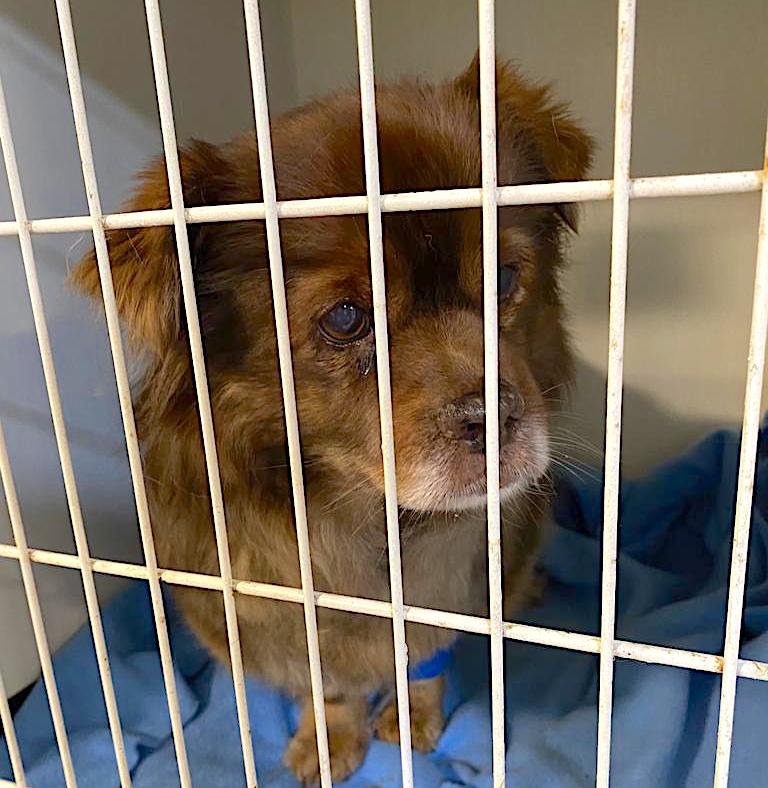Chemotherapy for Dogs
Theo’s Story
When Paola found Theo, she assumed he was probably lost. She posted his picture and waited for his family to come looking for him. But, sadly, no one called or texted. Paola brought Theo to our vet clinic to have him checked out. It was then that she learned that Theo had multiple ongoing health issues, and she knew it would be incredibly difficult to find a family who wanted to take in a 9 or 10-year-old dog in that condition, so she committed herself to caring for him.
Their bond has quickly grown, and Paola now describes Theo as her shadow. Where she goes, he follows, and she sees it as her mission to protect him.
Theo getting ready to head out into the rain with Paola
Among issues with his eyes, thyroid, a persistent cough, and a complication from his sterilization, Paola noticed Theo tended to limp. She did all she could to help Theo get treatment for each of his health concerns, but given his history and time spent on the street, she didn’t think much of the limp.
However, at one of his visits to our clinic, she mentioned that Theo sometimes limps, and after examining the leg more closely, our veterinarian decided to do an X-ray. Unfortunately, what she had hoped was a minor problem turned out to be a much bigger concern for Theo. Paola was devastated when our vets found a tumor and the blood results confirmed that Theo had cancer.
Theo’s cancer diagnosis was scary at first, but we worked with Paola to consider all potential treatments
Our team discussed all the options with Paola, and at the end she felt that he was too old to have his leg amputated and he still had some use of the paw, so she opted for chemotherapy. Paola’s hope was that this treatment would give Theo the best possible quality of life in his remaining years.
What exactly does chemotherapy for dogs look like?
Treatment Plan: Once the diagnosis is confirmed, the veterinarian develops a treatment plan tailored to the individual dog. Chemotherapy may be recommended as the primary treatment or in combination with other therapies, such as surgery or radiation therapy.
Administration: Chemotherapy drugs can be given to dogs in various ways, including intravenous (IV) injections, oral medications, or sometimes directly into the tumor (intratumoral chemotherapy). The frequency and duration of treatment will depend on the specific drugs used and the dog's response to treatment.
Potential Side Effects: Chemotherapy drugs target rapidly dividing cells, which includes not only cancer cells but also some normal healthy cells. As a result, dogs undergoing chemotherapy may experience side effects, such as nausea, vomiting, diarrhea, loss of appetite, and fatigue. However, not all dogs will experience severe side effects, and many can tolerate the treatment relatively well
Monitoring and Adjustments: Throughout the treatment, our veterinary team closely monitors the dog’s response to the chemotherapy. This may include regular blood tests and check-ups to evaluate the effectiveness of the treatment. If needed, the treatment plan can be adjusted based on the dog's progress or any changes in their health.
Pain Management: In cases where the tumor is causing discomfort, pain management will also be an essential part of the treatment plan. Pain medications or other pain relief techniques (eg: massage or physiotherapy) may be required to improve the dog's mobility and overall well-being.
Supportive Care: As with all we do at The GAAP, we approach the chemotherapy treatment with a holistic perspective. We like to consider the dog’s overall wellbeing, including their energy levels, mood/disposition, and any other health issues that may arise during the treatment. We recommend a healthy diet, regular exercise (as possible), and an environment that provides both comfort and appropriate stimulation.
Giving Theo some reassurance and comfort during a recent appointment
What has chemotherapy meant for Theo?
Paola notes that Theo’s pain has diminished considerably since he began his treatments. But it hasn’t always been easy. Theo has had days of nausea and lack of appetite. Still, his resilience shines. Paola reports that generally he’s bright and happy. We are taking his treatment step by step, and while we can’t be sure that Theo will ultimately win his battle against cancer, we can work to keep him as comfortable as possible so he can enjoy the rest of his days as Paola’s beloved shadow.
Unfortunately, not all animals have access to quality veterinary care. Your support can provide necessary care to dogs and cats in need when their owners cannot afford the full price.
You can make a real difference in the lives of animals like Theo!




